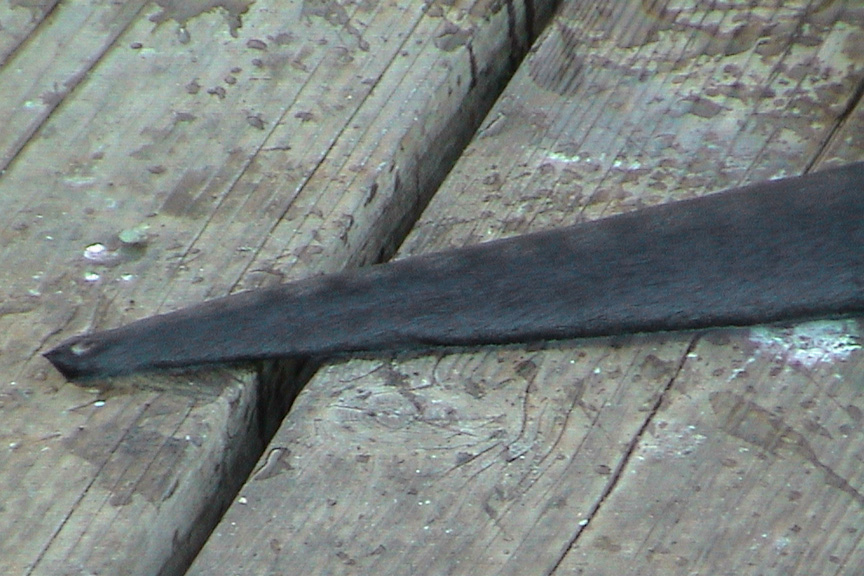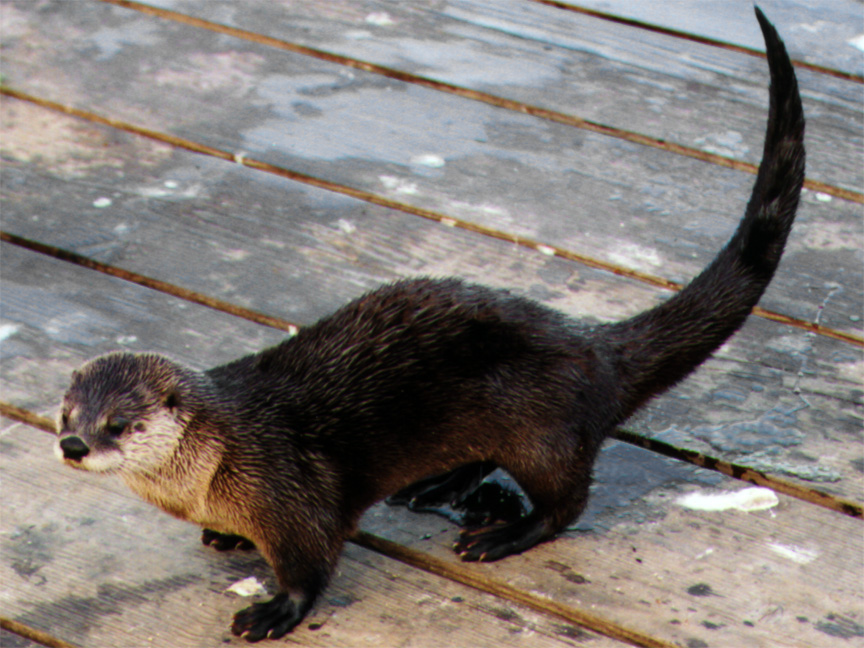Identifying Individual Otters, Page 5
byJ Scott Shannon
Not only do faces facilitate identification, tails can be useful, too. Little Mama had a distinctive curve to her tail when she was swimming and diving. Just seeing that peculiar tail flip 100 meters away, I knew that had to be Mom. Old Mama also had tail actions that allowed me to identify her at long distances. Scoots' tail itself is distinctive. Every spring, she develops a skin condition that causes the epidermis on her tailtip to slough off, and over the years, the end of her tail has eroded to become stumped and rounded, not pointy like the others (below). Her younger brother, Complainer, also develops this skin condition, though not as regularly as Scoots, and his tailtip is no longer pointed, as well.

The immigrant male "Buck" had behavioral idiosyncrasies that made him relatively easy to ID, but he also possessed what I call a "curly tail" (below). When standing still or walking slowly, Buck's tail formed a very smooth upwardly convex curve, like the incomplete curve of a circle. The otter pictured below is not Buck, however; it's Giant, Little Mama's littermate brother. On the basis of their shared curly tails and their physical resemblance, I speculated that Giant might have been Buck's father.

There are many other behavioral cues that help me identify otters visually. Just the way otters swim and dive can vary from individual to individual. Some otters keep their head above water when the glide on the surface; some have a habit of intermittently dipping their face just under the surface from time to time (I've come to associate face-dipping as a characteristic of an older dominant otter).
Some otters dive distinctively, too. Most otters dive underwater by arching their back and propelling themselves straight forward and down. Slick, however, turns on his side to dive and he always makes his initial propulsive kick with just one hind leg.
Teeth can also provide clues to identity. Otters 3 years old and younger have very sharp canine teeth that are easily seen when the animal eats. Otters start to lose their incisor teeth when they are 5-6 years old, and by this age, their canines are no longer sharp. By age 10, they have lost all of their incisors, and the canine teeth show significant wear. By the time Little Mama reached her 11th year, all of her teeth were reduced to mere ridges of exposed dentine.
Finally, individual otters can show affinities for particular places. Time after time, I'll see one particular otter in the same location. My notes contain many references to specific locations that, over time, I've come to associate with specific individuals: "Mom's Spot," "Ninety's Spot," "Complainer's Place," "Junior's Altar," "Scar's Cubbyhole," "Old Mom's Diagonal," "The Girls' Entrance," etc. These site affinities aren't exclusive, of course - other otters may occasionally use the same location, too - but when I see the same individual at the same place over and over again, this proves to be a reliable clue to identity more often than not.
In conclusion, even though there are a wide variety of physical and behavioral characteristics that I can use to identify individual otters, I'll freely admit that sometimes, I simply don't see enough of one of my otters to be able to identify them with assurance. In such cases, I am not at all hesitant to record "no ID" in my field notes. More often than not, though, I can tell which otter I'm looking at. There are only 4 otters here now at the time I'm writing this, and I have no trouble at all telling them apart if I can observe them for a few minutes at a relatively close distance.
So, you've seen for yourself now - identifying individual otters is far from impossible. All it really requires is paying attention, patience and persistence. These are also the basic characteristics of any good field naturalist or tracker. You'd be surprised how few biologists nowadays seem to possess these attributes. I guess I'm just from another time. I study behavior the old-fashioned way. I observe it!
[Home] [Previous Page] [1] [2] [3] [4] = 5 =
Text and Photographs Copyright © 2005-2025 by J Scott Shannon, All Rights Reserved. Contact:
